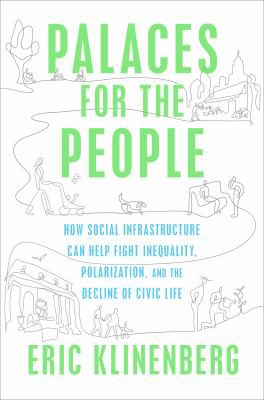“Palaces for the People”: Spaces and places for all of us
Posted on April 23, 2019 at 6:00 am

By Rachel Edmondson
I often hear people refer to Spokane as a big city with a small-town feel, and I think this is one of the reasons many people enjoy living in Spokane. However, when talking with customers and friends, I also hear more and more about how people don’t know their neighbors anymore. How our nation is becoming divided. How the increase in technology and social media has made us disconnected. If you pick up a newspaper, it doesn’t take long to find examples of polarization and a decline in civility.
Often, it all feels overwhelming. How did we get in this mess? Can it be fixed? If so, where do we even begin?
Recently, I’ve been finding some encouragement in a book recommended to me by a coworker. In his book, Palaces for the People: How Social Infrastructure Can Help Fight Inequality, Polarization, and the Decline of Civic Life, Eric Klinenberg suggests that the way forward is found in social infrastructure. I’d never heard of social infrastructure, but I found it more interesting than it initially sounds.
The basic idea of social infrastructure is that places and organizations either encourage interaction or discourage it. A social infrastructure that encourages interaction can actually make a city or town a better place to live. If a neighborhood has sidewalks and a park, people are much more likely to be out walking and playing, and therefore, they have more opportunities to meet their neighbors.
This can have a domino effect of instilling more pride in how the neighborhood looks and creating neighborhoods that are safer because they are well taken care of. In fact, research shows that communities are healthier, and people are happier, when a strong social infrastructure is in place. So in a culture where many people feel lonely, alienated, or distrustful, having places that bring us together are critical to healing rifts and moving forward.
Small occurrences like running into the same person during your jog through the park each week or saying hello to the other parents during school drop off can seem trite. But these interactions make us see others in a more genuine way. The more places that encourage interaction rather than isolation, the better off a community is.
I must confess, one of the reasons why I’m enjoying this book so much is that Klinenberg spends a decent amount of time praising libraries. In fact, he believes that libraries are among the most critical forms of social infrastructure that we have.
Unfortunately, he also thinks they are one of the most undervalued. I’ve found that most people think of libraries with a touch of nostalgia, which is a good thing. However, there are those that think libraries are becoming obsolete. Not only is this disappointing, it’s also far from the truth.
A 2016 survey conducted by the Pew Research Center found that about half of all Americans sixteen and over had used a public library in the past year.
There are a lot of people coming in and out of the doors of libraries, and while books will always be important, it’s not all about the books. Libraries have continued to reinvent themselves, offering programs to meet the educational and social needs of their communities.
Spokane County Library District offers passes to Washington State Parks, Mobius Science Center and Children’s Museum, and the Northwest Museum of Arts and Culture. We lend sewing machines and digital cameras.
I’ve helped people use our computers to fill out and turn in job applications. I’ve had moms tell me that when they first moved to Spokane, they felt sad and lonely and storytime was a lifeline, giving them a place to meet other moms and discover a new community.
Libraries are places where people can enjoy one another’s company regardless of age, class, race, or ethnicity. In storytime alone, I’ve had babies with grandparents and all ages in between, and it’s not uncommon to hear multiple languages during playtime.
But Palaces for the People is much more than just a love song to libraries. I found Klinenberg’s research and stories about how physical places affect the ways we interact to be an interesting and quick read. What it ultimately comes down to is communities are stronger when people are involved with each other.
There’s no shortage of places where we can find privacy and space to hide away, but where are places we can meet where we feel like we belong, where we feel ownership? How do we increase a sense of connectedness and decrease isolation?
When the library held community conversations as part of developing our community engagement plan, one member of our community made a statement that really resonated with me. This person said, “If we know each other face to face, we see people as people, instead of as two-dimensional figures that we don’t have to care about.”
Just maybe the way forward is creating more spaces and organizations that encourage these face-to-face interactions. Maybe the way forward is developing and valuing Spokane’s social infrastructures so that people have opportunities to really see and care about one another. Maybe the way forward is libraries.
FURTHER READING & LISTENING
Check out this article of an interview with Eric Klinenberg, author of Palaces for the People.
Listen to this podcast with Eric Klinenberg, author of Palaces for the People.

Tags: civic life, community, grandparents, inequality, kids, libraries, library, neighborhoods, neighbors, nonfiction, Palaces for the People, parents, parks, places, polarization, public life, schools, social, social infrastructure, social science, society, spaces, teachers, together

